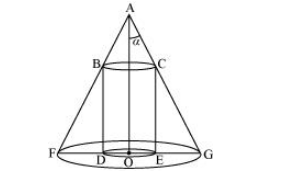Show that height of the cylinder of greatest volume which can be inscribed in a right circular cone of height h and semi vertical
Show that height of the cylinder of greatest volume which can be inscribed in a right circular cone of height $h$ and semi vertical angle $\alpha$ is one-third that of the cone and the greatest volume of cylinder is $\frac{4}{27} \pi h^{3} \tan ^{2} \alpha$.
The given right circular cone of fixed height (h) and semi-vertical angle (α) can be drawn as:

Here, a cylinder of radius R and height H is inscribed in the cone.
Then, $\angle \mathrm{GAO}=\alpha, \mathrm{OG}=r, \mathrm{OA}=h, \mathrm{OE}=R$, and $\mathrm{CE}=H$.
We have,
r = h tan α
Now, since ΔAOG is similar to ΔCEG, we have:
$\frac{\mathrm{AO}}{\mathrm{OG}}=\frac{\mathrm{CE}}{\mathrm{EG}}$
$\Rightarrow \frac{h}{r}=\frac{H}{r-R} \quad[\mathrm{EG}=\mathrm{OG}-\mathrm{OE}]$
$\Rightarrow H=\frac{h}{r}(r-R)=\frac{h}{h \tan \alpha}(h \tan \alpha-R)=\frac{1}{\tan \alpha}(h \tan \alpha-R)$
Now, the volume (V) of the cylinder is given by,
$\mathrm{V}=\pi R^{2} H=\frac{\pi R^{2}}{\tan \alpha}(h \tan \alpha-R)=\pi R^{2} h-\frac{\pi R^{3}}{\tan \alpha}$
$\therefore \frac{d V}{d R}=2 \pi R h-\frac{3 \pi R^{2}}{\tan \alpha}$
Now, $\frac{d V}{d R}=0$
$\mathrm{V}=\pi R^{2} H=\frac{\pi R^{2}}{\tan \alpha}(h \tan \alpha-R)=\pi R^{2} h-\frac{\pi R^{3}}{\tan \alpha}$
$\therefore \frac{d V}{d R}=2 \pi R h-\frac{3 \pi R^{2}}{\tan \alpha}$
Now,$\frac{d V}{d R}=0$
$\Rightarrow 2 \pi R h=\frac{3 \pi R^{2}}{\tan \alpha}$
$\Rightarrow 2 h \tan \alpha=3 R$
$\Rightarrow R=\frac{2 h}{3} \tan \alpha$
Now, $\frac{d^{2} V}{d R^{2}}=2 \pi h-\frac{6 \pi R}{\tan \alpha}$
And, for $R=\frac{2 h}{3} \tan \alpha$, we have:
$\frac{d^{2} V}{d R^{2}}=2 \pi h-\frac{6 \pi}{\tan \alpha}\left(\frac{2 h}{3} \tan \alpha\right)=2 \pi h-4 \pi h=-2 \pi h<0$
∴By second derivative test, the volume of the cylinder is the greatest when
$R=\frac{2 h}{3} \tan \alpha .$
When $R=\frac{2 h}{3} \tan \alpha, H=\frac{1}{\tan \alpha}\left(h \tan \alpha-\frac{2 h}{3} \tan \alpha\right)=\frac{1}{\tan \alpha}\left(\frac{h \tan \alpha}{3}\right)=\frac{h}{3}$.
Thus, the height of the cylinder is one-third the height of the cone when the volume of the cylinder is the greatest.
Now, the maximum volume of the cylinder can be obtained as:
$\pi\left(\frac{2 h}{3} \tan \alpha\right)^{2}\left(\frac{h}{3}\right)=\pi\left(\frac{4 h^{2}}{9} \tan ^{2} \alpha\right)\left(\frac{h}{3}\right)=\frac{4}{27} \pi h^{3} \tan ^{2} \alpha$
Hence, the given result is proved.
Click here to get exam-ready with eSaral
For making your preparation journey smoother of JEE, NEET and Class 8 to 10, grab our app now.
